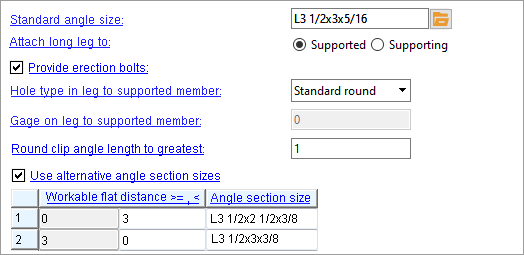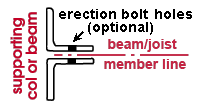 All-Welded Attached to Supporting Clip Angles ( Fabricator Settings )
All-Welded Attached to Supporting Clip Angles ( Fabricator Settings )
To specify this type of standard clip angle in the model :
home > project settings > fabricator > pIecemarking > | clip configurations | top
![]() To open this window :
To open this window :
You can open this window using any one (1) of the following methods:
Method 1 : Home > Project Settings > Fabricator > PIecemarking > All-Welded Clip Angles > All-Welded Attached to Supporting Clip Angles .
Password protection: If a password has been set using the Change Setup Password utility, you can open this window only if you first enter that exact password.
home > project settings > fabricator > pIecemarking > | clip configurations | top
------ Settings ------
Standard angle size: The preferred angle section size . The angle must be listed in the local shape file. Note that alternative angles can also be specified on this window.
To enter an angle section size: Either type in the section size that you want (e.g., ' L4x3 1/2x5/16 '), or press the "file cabinet" browse button (
) and choose an angle section from the list of angles in the local shape file .
Also see: If you enter a size that has unequal legs, be sure to specify (below) whether you want to " Attach long leg to " the ' Supported ' or ' Supporting ' member.
Attach long leg to: Supported or Supporting . This applies when a " Standard angle size " with unequal legs has been entered. Example: The long leg for L3 1/2x3x5/16 angle material is the leg that is 3 1 /2 inches in length.
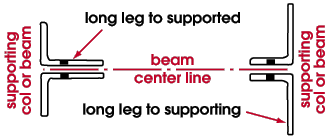
The erection bolt holes shown in this illustration are optional.
' Supported ' field welds the long leg of the angle to the supported beam or joist. Erection bolts can also, optionally, be provided for field bolt attachment of the to-supported leg.
' Supporting ' fastens the long leg of the angle to the supporting beam or column.
Provide erection bolts: ![]() or
or ![]() . This sets whether or not erection bolts are provide when ' Automatic ' is the choice made to " Use erection bolts " in the "
. This sets whether or not erection bolts are provide when ' Automatic ' is the choice made to " Use erection bolts " in the " ![]() Connection specifications " for an auto standard , user defined or beam-window-specified All-Welded Attached to Supporting Clip Angles double clip angle. The choice made here can be overridden in "
Connection specifications " for an auto standard , user defined or beam-window-specified All-Welded Attached to Supporting Clip Angles double clip angle. The choice made here can be overridden in " ![]() Connection specifications. "
Connection specifications. "
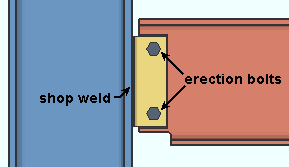
If this box is checked (
), erection bolts are provided when ' Automatic ' is the choice made to " Use erection bolts " in "
Connection specifications ." For a beam end connection that is not auto standard, the bolts are the "
Connection type " > " NM bolt type to supported " and " NM bolt diameter " that are specified for that beam connection's end. For an auto standard beam connection, the bolts are the " NM bolt type " and " NM bolt diameter " that is specified for that connection at Home > Project Settings > Fabricator > Auto Standard Connections . Erection bolts are field bolts. For an All-Welded Attached to Supporting Clip Angles double clip angle, two erection bolts are needed to provide temporary field attachment to the beam for field welding.
If the box is not checked (
), the All-Welded Attached to Supporting Clip Angles clip angles are designed without erection bolts when ' Automatic ' is the choice made in "
Connection specifications ."
Hole type in leg to supported member: Standard round or Short slot or Long slot or Oversized or User slot #1 or User slot #2 . The choice made here applies when " Provide erection bolts " (above) is turned on (checked) and " Use erection bolts " in " ![]() Connection specifications " is set to ' Automatic '. It also applies -- regardless of the choice made above -- when " Use erection bolts " in "
Connection specifications " is set to ' Automatic '. It also applies -- regardless of the choice made above -- when " Use erection bolts " in " ![]() Connection specifications " is set to ' Yes '.
Connection specifications " is set to ' Yes '.
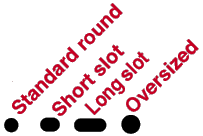
Effect on connection design: The hole type selected here applies to the clip angle leg to the supported beam or the knife plate of the joist.
Examples: A ' Standard round ' hole is typically designed to be 1/16 inch larger than the bolt diameter. An ' Oversized round ' hole is typically designed to be 1/8 inch larger than the bolt diameter.
Gage on leg to supported member: The distance (in the primary dimension " Units " or other units ) from the outside corner of the clip angle to the center of the column of holes for erection bolts to the supported beam or the knife plate of the joist.
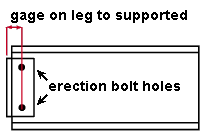
Applicability: The choice made here applies when " Provide erection bolts " (above) is turned on (checked) and " Use erection bolts " in "
Connection specifications " is set to ' Automatic '. It also applies -- regardless of the choice made above -- when " Use erection bolts " in "
Connection specifications " is set to ' Yes '.
Round clip angle length to greatest: The distance (in the primary dimension " Units " or other units ) that you want connection design to increment the length of clip angles (e.g., 1/2 makes connection design round angle length up to the nearest half inch).

Effect on connection design: When connection design creates All-Welded Attached to Supporting Clip Angles clip angles, it starts with a clip angle of minimum length, which is roughly -- depending on the " Connection design method " -- half the T distance of the supported beam. The T distance is the distance between web fillets for a wide flange or channel shape. If limit state connection strength capacity checks require that the clip angle length be increased from the minimum, connection design rounds up to the nearest multiple of the distance entered here.
home > project settings > fabricator > pIecemarking > | clip configurations | top
------ Alternative angles for welding to supporting members ------
|
|
Use alternative angle section sizes: ![]() or
or ![]() .
.
If this box is checked (
), connection design looks at the workable flat distance on the face of the supporting member that the double clip angles are to be shop welded to, then selects the angle from the alternative angles table (described below).
If the box is not checked (
), connection design uses the " Standard angle size ."
Workable flat distance is greater than or equal to
( >= )Workable flat distance is less than
( < )Angle section size The values in the first column are filled in automatically. They represent the lowest workable flat distance at which the " Angle section size" entered in a particular row will be applied.
The values in the second column can be filled in manually. Each such value represents the largest workable flat distance at which the " Angle section size " entered in a particular row will be applied. The angle to be welded within the workable flat distance on the supporting member. You need to account for the welds and the thickness of the supporting beam's web as well as the angle leg size when determining if the angle will fit in the specified workable flat distance.
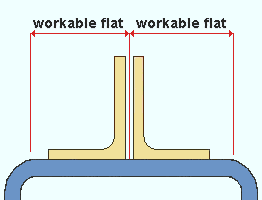
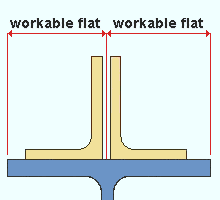
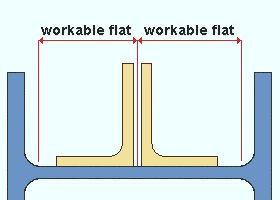
home > project settings > fabricator > pIecemarking > | clip configurations | top
![]() To close this window :
To close this window :
"OK" (or the Enter key) closes this window and saves the settings on it to the current Fabricator that is currently loaded in your current Job .
Note: If you want changes to this window applied to particular members, you can Process Selected Members then Process and Create Solids . Or you can Mark Members for Processing then Process and Create Solids .
"Cancel" (or the Esc key or the ![]() button) closes this window without saving any changes made to it.
button) closes this window without saving any changes made to it.
"Reset" undoes all changes that you made to this window since you first opened it. The window remains open.
home > project settings > fabricator > pIecemarking > | clip configurations | top
